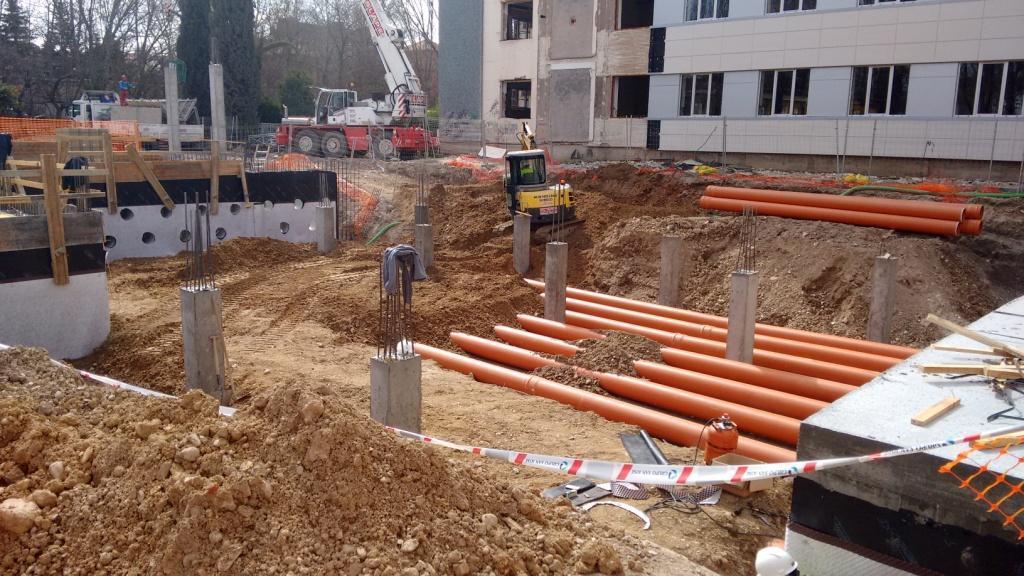In a recent post, Heating and Cooling: What is Canadian Well (Part 1), we saw what is a Canadian Well. It is a technique which allows us to take advantage of the vast underground heat. The design is based on the installation and movement of air ducts at a depth between 2 and 4 meters and a length of about 35 meters in the subsoil. The duct may be made of one single tube, multiple connected tubes, arranged around the house in a straight line, meanders, or loops.
Now, this post will cover the choice of materials to build your Canadian Well.
Choice of materials

The choice of materials is critical to the life of your Canadian well. Here are the recommended optimal characteristics:
– a smooth inner wall (prevents deposits of dirt and bacteria);
– a material resistant to high heat (without the release of toxic fumes);
– a resistant material (avoids the risk of tearing and thus ensures a good seal).
Be careful not to use glue for any connections, as there is a risk of toxic fumes being released during high temperatures.
Terracotta or stoneware
This material is ideally suited for use in the Canadian well, due to its specifics:
– a good thermal conductivity (Lambda = 1.16): 4 times higher than polyethylene and polypropylene;
– no condensation with the stoneware tubes: this material regulates the humidity level by storing it in its walls;
– a slightly higher price than polyethylene;
– very ecological (gray energy 1000 times less than polyethylene);
– a perfect sealing thanks to the connection sleeve fitted with an elastomer lip seal that fits perfectly to the outside of the tube and allows ground movements;
– the stoneware pipes are core-tight thanks to the “black core” (non-release of carbon during cooking), according to the NF EN 295-3 standard;
– a healthy and natural material: no binder or chemical additives, just clay, sand, water and firing;
– a tightness of the pipes and fittings guaranteed for life;
– a good longevity: the Romans used sandstone pipes;
– no deformation due to load lowering;
– a good quality of the air entering the house, both on the hygrometric point and on the sanitary point;
– not to be confused with tubes varnished on the inside (collar tubes).
Note: Terracotta should be handled with care as it breaks easily at the slightest shock.
Polypropylene
Polypropylene is a very feasible solution for Canadian well piping because of its many characteristics:
– a good thermal conductivity (Lambda = 0.35) 2 times higher than PVC;
– the presence of condensation (several litres for a hot day);
– a moderately high price;
– a smooth interior;
– a smooth exterior;
– an anti-bacterial layer on the inside to limit the development of bacteria due to stagnant water;
– an excellent longevity;
– a very resistant material, except in sheathing (give preference to bars);
– a watertightness (to be checked at the connection with the manhole).
Polypropylene is an expensive material but its price is justified by its characteristics perfectly adapted for external ducts. It is not ecological (very high gray energy).
High-density polyethylene (HDPE)
High-density polyethylene is a feasible solution for Canadian well piping:
– thermal conductivity (Lambda = 0.35) twice as high as PVC;
– presence of condensation (several litres per day of high heat);
– moderately high price;
– smooth interior;
– corrugated outside;
– very rigid: excellent resistance (if coated with an incompressible material);
– no toxic emissions in case of high heat;
– used for drinking water supply.
Polyethylene (PE)
Polyethylene is another feasible solution for Canadian well piping:
– thermal conductivity (Lambda = 0.35);
– presence of condensation (several litres per day of high heat);
– low price;
– smooth interior: good drainage of condensate;
– corrugated outside;
– medium resistance: not to be buried too deep to guarantee its longevity;
– more ecological material than PVC for a similar price;
– used as an electric sheath.
Cast iron
Cast iron is a very feasible solution for Canadian well piping:
– thermal conductivity (Lambda = 50);
– presence of condensation;
– high price;
– not ecological (very high gray energy);
– rigid and resistant;
– good longevity;
– watertight thanks to elastomer seal connections;
– beware of galvanic corrosion (electron exchange that punctures the cast iron);
– 45° elbows without clamping flange (possible sealing problem);
– in spite of an internal coating, it would seem that rust is forming.
Make sure that the outside of your pipe is treated against corrosion to ensure a good seal over the long term.
Concrete
Concrete should be avoided because it is not waterproof.
It is better used for sanitation and rainwater drainage.
PVC
Although available on the market, PVC pipe should be avoided:
– thermal conductivity (Lambda = 0.17);
– presence of condensation;
– low price;
– not ecological (very high gray energy);
– risk of toxic emissions in case of high heat;
– can lead to unpleasant odours;
– interior not smooth enough to prevent the deposit of bacteria.
PVC is the cheapest material, but its characteristics make it the least suitable and most hazardous to health.
So, that’s it. Now you are better informed about Canadian Wells. Contact professionals directly to obtain a free personalized quote. And, remember to share your experience below.

